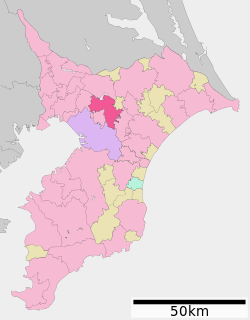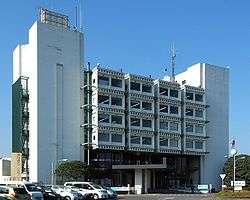Sakura, Chiba
| Sakura 佐倉市 | |||
|---|---|---|---|
| City | |||
|
Yuukarigaoka district of Sakura | |||
| |||
 Location of Sakura in Chiba Prefecture | |||
 Sakura
| |||
| Coordinates: 35°43′N 140°13′E / 35.717°N 140.217°ECoordinates: 35°43′N 140°13′E / 35.717°N 140.217°E | |||
| Country | Japan | ||
| Region | Kantō | ||
| Prefecture | Chiba Prefecture | ||
| Government | |||
| • Mayor | Kazuo Warabi | ||
| Area | |||
| • Total | 103.59 km2 (40.00 sq mi) | ||
| Population (December 2014) | |||
| • Total | 177,601 | ||
| • Density | 1,714/km2 (4,440/sq mi) | ||
| Time zone | Japan Standard Time (UTC+9) | ||
| -Tree | Sakura | ||
| - Flower | Hanashōbu (Iris ensata var. ensata) | ||
| Phone number | 043-484-1111 | ||
| Address | 97, Kairinjimachi, Sakura-shi, Chiba-ken 285-8501 | ||
| Website | City of Sakura | ||

Sakura (佐倉市 Sakura-shi) is a city located in northern Chiba Prefecture, Japan.
As of December 2014, the city has an estimated population of 177,601 and a population density of 1714 persons per km². The total area is 103.59 km².
Geography
Sakura is located in northeastern Chiba Prefecture on the Shimōsa Plateau.[1] It is situated 40 kilometers northeast of the Tokyo and 15 kilometers from Narita International Airport. Chiba City, the prefectural capital, lies 15 kilometers southwest of Sakura. Lake Inba and the Inba Marsh form the northern city limits.[2][3]
Neighboring municipalities
- Chiba, Chiba
- Narita, Chiba
- Yotsukaido, Chiba
- Yachiyo, Chiba
- Inzai, Chiba
- Yachimata, Chiba
- Shisui, Chiba
History
The area around Sakura has been inhabited since prehistory, and archaeologists have found numerous Kofun period burial tumuli in the area, along with the remains of a Hakuho period Buddhist temple. During the Kamakura and Muromachi periods, the area was controlled by the Chiba clan. During the Sengoku period, the Chiba clan fought the Satomi clan to the south, and the Late Hōjō clan to the west. After the defeat of the Chiba clan, the area came within the control of Tokugawa Ieyasu, who assigned one of his chief generals, Doi Toshikatsu to rebuild Chiba Castle and to rule over Sakura Domain as a daimyō.[2] Doi rebuilt the area as a jōkamachi, or castle town, which became the largest castle town in the Bōsō region.[1][3] Under the Tokugawa shogunate, Sakura Domain came to be ruled for most of the Edo period under the Hotta clan. In the Bakumatsu period the domain became a center for rangaku studies, centered on the Juntendō school of the doctor Taizen Satō (1804 – 1872).[1][4] The Juntendō and other educational institutions in Sakura contributed greatly to the Meiji Restoration.[1] After the abolition of Sakura Domain, the area eventually became part of Chiba Prefecture.
Sakura Town was one of several towns and villages created on April 1, 1889 under Inba District. On March 31, 1954, Sakura achieved city status through merger of the neighboring municipalities of Usui, Wada, Nego, Yadomi and Shizu.[1]
Economy
Sakura is a regional commercial center and, due to its numerous train connections, a bedroom community for nearby Chiba and Tokyo.
Education
- Keiai University branch campus
- Chiba Keiai Junior College
- Wayo Women's University branch campus
Transportation
Railway
- JR East - Narita Line, Sōbu Main Line
- Keisei Electric Railway - Keisei Main Line
- Shizu - Yūkarigaoka - Keisei-Usui - Keisei-Sakura - Ōsakura
- Yamaman - Yamaman Yūkarigaoka Line
- Yūkarigaoka - Chiku Center - Kōen - Joshidai- Chūgakkō - Ino
Highway
Local attractions

Sakura boasts a number of tourist attractions, including the large National Museum of Japanese History (http://www.rekihaku.ac.jp, phone 043-486-0123, address 117 Jonai-cho) located on the ruins of Sakura Castle in the Sakura Castle Park.[2] Several samurai houses near the old castle are open to the public and are protected as Important Cultural Properties. Other sights of interest include the Tsukamoto Sword Museum, Sakura Museum of History and Folklore, Sakura City Museum of Art, and the Sakura Juntendo Memorial Building. Nearby is also the Kawamura Memorial Museum of Art. In 1994 on the 40th anniversary of the city’s foundation a Dutch windmill called De Liefde was erected by the Dutch millwright company "Verbij Hoogmade BV" on the south-eastern shore of Lake Inba as a landmark of Sakura Furusato Square. The mill serving as a polder mill is named after the first Dutch sailing ship which landed on the Japanese shore in 1600. It is the only windmill of this type in Japan (a so-called "ground-sailer", which means a windmill whose sails reach almost down to the ground.
Noted people from Sakura
- Hayashi Tadasu – Meiji period statesman
- Tsuda Sen – Meiji period statesman
- Nagashima Shigeo – Professional baseball player
References
- 1 2 3 4 5 6 "佐倉(市)" [Sakura (City)]. Nihon Daihyakka Zensho (Nipponika) (in Japanese). Tokyo: Shogakukan. 2012. OCLC 153301537. Retrieved 2012-06-20.
- 1 2 3 "Sakura". Encyclopedia of Japan. Tokyo: Shogakukan. 2012. OCLC 56431036. Retrieved 2012-06-30.
- 1 2 "佐倉" [Sakura]. Dijitaru daijisen (in Japanese). Tokyo: Shogakukan. 2012. OCLC 56431036. Retrieved 2012-06-24.
- ↑ "佐藤泰然" [Satō Taizen]. Nihon Daihyakka Zensho (Nipponika) (in Japanese). Tokyo: Shogakukan. 2012. OCLC 153301537. Retrieved 2012-06-29.
External links
| Wikimedia Commons has media related to Sakura, Chiba. |
- Sakura City official website (Japanese)
- Sakura City official website (English)


